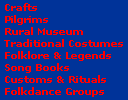





| Traditional Costumes | |
|
A people's traditional costume is simply one
of its numerous socio-cultural and historical indicators and reflects,
per se, the various parameters that contribute to the cohesiveness
of any given social unit. Generally speaking, the features of Portuguese
traditional dress reveal that the main activities in the territory
were farming and fishing.The fishing industry is echoed in the
bare feet that complement the costumes of the coastal regions
as was required by the frequent contact with its sandy beaches
and seawater. The hinterland regions complement their regional
costumes with the wooden clog, a hardy solution for its often
uneven and rocky terrain. Tending to the land in the deep furrows
of steep valleys and harsh winter and summer temperatures calls
for good, efficient physical and thermal protection of the foot. The demands of the chores traditionally carried
out by women on the beaches or in the interior, such as the transportation
of foodstuffs on their heads, resulted in the inclusion of the
turban or "rodilho" in many traditional costumes as
a form of protection from the heavy loads that women were subject
to, namely, baskets, cans and water jugs, that so much nurtured
their homes and the Portuguese economy.The waistcoat, hemp and
linen shirts and breeches that are often seen in everyday male
costumes mirror the practicality demanded by the arduous labour
inherent to the farming and fishing industries. Sober colours like black and dark brown and bright
colours such as red, green and blue and materials such as hemp,
linen, cotton provided thermal protection in outdoor chores often
carried out under a blazing sun or the cutting cold of frosty
winters. Traditional Portuguese jewellery, a complementary accessory to its traditional costume, mirrors the influences of the Roman, Celtiberian and Moorish civilizations that throughout the ages forged the culture of the peoples of this region, having reached its peak in its fine filligrain pieces. In a world of constant political and economic
change, gold, along with land, became the only safe investment
able to be passed down from generation to generation. The solemn wedding and Sunday dress frequently kept and used as a shroud in Life 's last and final journey, manifest the sober religious and moral codes of Catholicism that, for centuries, prevailed amongst the peoples of Portugal. The church, marriage and death were considered the most important landmarks of collective and individual social life. Despite their similarities from north to south,
the traditional costumes of Portugal also differ greatly, thus
making it perfectly possible to identify the uniqueness of every
one of the regions that comprise the country's territory. |
|
